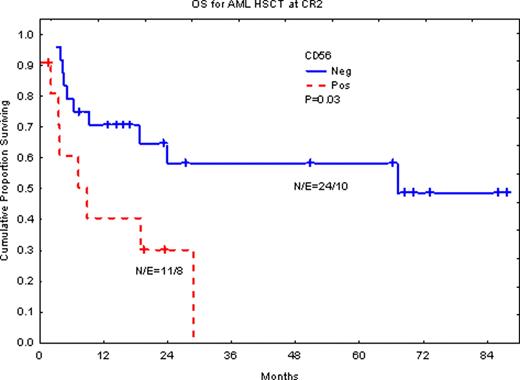Abstract
Abstract 4880
The CD56 is a neural cell adhesion molecule (N-CAM) expressed in natural killer cells. CD56 expression on the surface of leukemic cells in acute myeloid leukemia (AML) has been reported to correlate with higher rate of relapse and to be associated with poor outcome when patients are treated with conventional intensive chemotherapy. The role of allogeneic hematopoietic stem cell transplantation (HSCT) in improving outcome in this subgroup of AML patients is not known. We investigated whether the outcome of CD56-positive AML patients differ from average AML patients when treated with allogeneic HSCT after intensive chemotherapy and its prognostic relevance in patients transplanted in the first (CR1) or second complete remission (CR2).
Immunophenotyping data of 106 patients with AML who were treated with allogeneic HSCT was reviewed. The expression of the CD56 on the blast population as determined by flow cytometry was correlated with clinical data and outcome. The median age of patients was 24 (range: 14–57) and included 72 patients in the intermediate cytogenetic group and 30 in the adverse cytogenetic group. Of the 106 patients, 71 (67%) were treated with HSCT in their first remission (CR1) and the remaining patients were treated in CR2.
Twenty nine (28%) of all studied patients expressed CD56 on the surface of the blasts at diagnosis. When we consider only patients treated with HSCT in CR1, 17 (24%) were CD56 positive. The overall survival (OS) and event free survival (EFS) for patients who were positive for CD56 were not significantly different from the rest of the patients in the CR1 group. In contrast, in the group of patients who were treated with HSCT after relapsing (CR2), patients with CD56 positivity had significantly shorter OS (P=0.03) and DFS (P=0.006). In this group, 11 of the 35 (31%) were CD56+ and their median survival was 8.85 months while the median has not been reached in the CD56 negative patients.
Our data suggests that the expression of CD56 in AML is a significant poor prognostic factor if patients are treated with HSCT after relapsing in their second remission. Although this should be confirmed in larger studies, the CD56 expression in AML should be considered as an adverse risk factor and favors treatment with allogeneic HSCT in the first remission and not after relapse in second remission. AML patients with CD56 positive blasts have higher incidence of relapse after chemotherapy and they might lose their opportunity of good outcome if HSCT is delayed and performed only in the second remission.
No relevant conflicts of interest to declare.
Author notes
Asterisk with author names denotes non-ASH members.


This feature is available to Subscribers Only
Sign In or Create an Account Close Modal